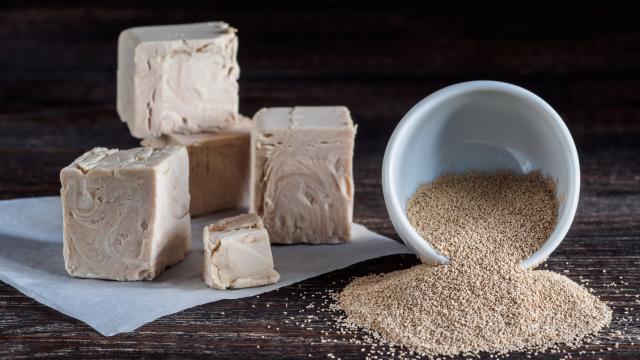One of the most common baking questions I get is what to do when a recipe calls for instant yeast, but all you have is active dry. Just how different are they, and does it even matter which kind you use?
I’m thrilled to report that no, it does not. All three types of commercial yeast — instant, active dry, and cake — do the same thing and can be used interchangeably with some slight adjustments. You just need to know which type you have and what makes it tick.
Instant and active dry yeasts are super common and nearly identical. Both are preserved via drying, which gives them the same superfine, pebbly texture. Prevailing wisdom says you should mix instant yeast in with the dry ingredients, while active dry should be dissolved — or “bloomed” — in the wet ingredients. This is a solid rule of thumb: Instant yeast is designed to activate during the mixing process, while active dry works best with a little head start. But it may surprise you to learn that both techniques work perfectly fine for both types of yeast if the liquid ingredients are the right temperature.
According to Red Star Yeast’s usage instructions, these are the maximum liquid ingredient temperatures for each method:
- Yeast added to dry ingredients: 50-55ºC — noticeably warm to the touch, but not hot.
- Yeast bloomed with wet ingredients: 45-47ºC — barely warm.
Yeast is most active within these ranges. It’s OK to go slightly colder — it’ll just take longer for the yeast to do its thing — but higher temperatures will kill the yeast.
This is more for reassurance than anything else. Recipes don’t often include instructions for both types of yeast, so you might end up blooming instant yeast or adding active dry to the flour without realising it — and then freaking out once you do. Don’t panic! As long as your liquid ingredients aren’t too hot and your yeast is alive, it doesn’t really matter how you add them to your dough.
On that note, there’s one scenario where blooming is always the right move, even for instant yeast. If you have absolutely no idea how old that jar of yeast is, bloom it first. Sprinkle a few pinches into lukewarm water, give it a stir, and let it sit for 5-10 minutes. If it doesn’t turn foamy and bubbly, it’s dead and you need to get a fresh jar.
That leaves cake yeast, which is also called “fresh” or “compressed yeast.” It’s not dried at all, and its high water content presents some challenges. For one thing, it’s not shelf-stable, so good luck finding it in stores. You need a lot more cake yeast than dry to get the same results — Red Star Yeast recommends a little less than three times more by weight — and it’s delicate. How delicate is it? It’s so delicate that liquids hotter than 32-35ºC will kill it dead. But other than that, it can be used exactly like dry yeast: Crumble it over the dry ingredients and go.
So, which kind should you use? Probably not cake yeast — it’s fun to mess around with once in a while, but too impractical for regular use. The choice between instant and active dry boils down to personal preference. I use instant yeast because I bake a lot and it’s easy to find in large quantities. If you’re a sporadic baker, active dry yeast packets are less of a commitment and work just as well.

Leave a Reply
You must be logged in to post a comment.